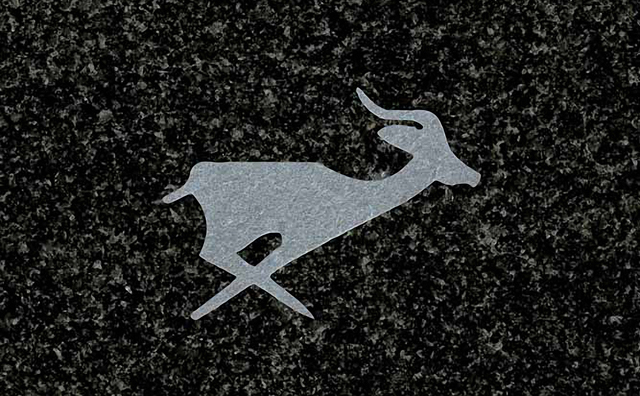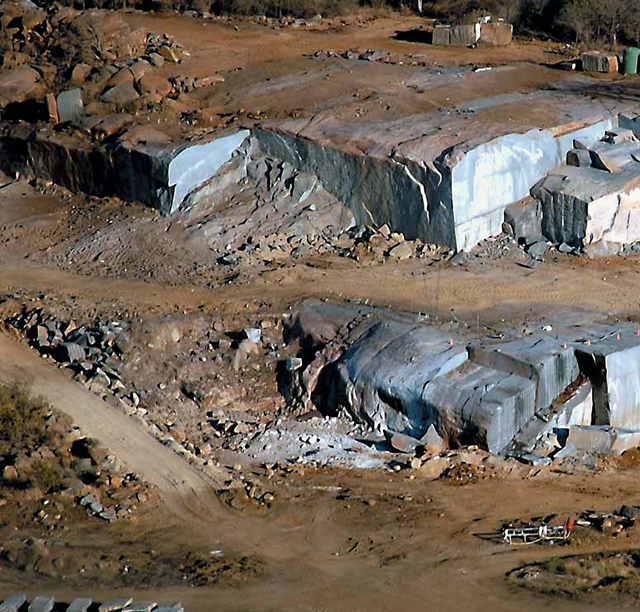NERO IMPALA IN VARIANTS B

We continue the topic from the previous issue of our magazine and present other localities on the African continent where black gabronoids are mined.
Nell’s deposit
Nell’s is probably the oldest deposit in the Rustenburg region. The mining of Nero Impala-type material began in 1947. The first mining company was Nell Brothers, based in Bon Accord, north of Pretoria. At that time, the deposit was a source of very dark fine-grained material and mining continued there until the early 1980s. However, demand declined and resources of the darkest material were slowly depleting. For these reasons, mining was ended there around 1985.
In 2003, the Marlin Group (of which the Polish company called M + Q is a part) became interested in the deposit with the aim to resume mining. At present, the material is mined in a quarry south of the original mining site. The obtained fine-grained material can be described as medium dark to dark. The big disadvantage is that almost 50% of the mined material contains defects in the form of grouped crystals of feldspar placed perpendicularly to the surface. They are visible on a well-polished stone when wet.

Mining is done towards the old quarry in the expectation that the quality of the rock will improve and the mined materials will be darker. The current volume of extraction is almost 3,000 m3. The reserves of the deposit are estimated at 20 years.
The dark material from this deposit is marked NL-D and represents 25% of the extraction. The remaining material is medium dark and bears the designation NL-MD. Most blocks are medium in size.
Nell’s is the last deposit from which the extracted material can be considered Nero Impala. However, another type of gabronoid known as Nero Africa is also mined in the region.
Wonderkop deposit
The deposit was operated by Impala Granite in 1988. Following the merger of Impala Granite with Kudu Granite in 1992, market demand declined and mining ceased. It was Marlin Group that resumed mining in the deposit in 2004. The reason was the revival of interest in dark materials.

The deposit is located in subzone B, in which two forms of orthopiroxenes are mixed – inverted pigeonites typical of Nero Impala and common orthopyroxenes.
The difference between the Wonderkop material and the classic Nero Impala lies in the greater contrast between dark orthopiroxenes and light feldspar crystals.
The stone is mined in the amount of about 3,000 m3. The reserves of the deposit are estimated at 30 years. Most of the mining consists of blocks of medium-dark rock with the designation WK. Medium-sized blocks make up 20% of the extracted material.
Elandsfontein deposit
In this quarry located on the outskirts of the town of Brits, stone is mined, which is defined as medium (marked E-M and E-ML) in terms of colour. Mining also includes the light variety (E-L).

The stone from this deposit is characterized by the presence of very light crystals of feldspar, strongly contrasting with dark orthopyroxenes.
This gabbro is very popular on the South African market. Mining in this deposit was started in 2003 and the annual extraction is approximately 1,500 m3.
Berseba deposit
Barseba is located in subzone R of the Bushveld massif. Mining was started there by the Marlin Group in 1995.
The quality of the material shows certain limits, which is related to the presence of magnetite crystals, which may disintegrate and cause the occurrence of rusty spots under the influence of weather conditions. There are also some problems with the porosity of the rock.

For these reasons, the material is not recommended for use on exterior cladding, tombstones or kitchen worktops.
Approximately 2,500 m3 of the material is extracted from the deposit annually.
Material resources are estimated at 10 years. The colour of the material is classified as medium (mark B-BC).
Deposits of Keeley Granite company
Keeley Granite deposits are also located in the Bushveld area.
Keeley Granite belongs to a JVK joint venture called Finstone S.a.rl. (owner of Marlin Group) and R.E.D. Graniti SpA. This company, also known as Kelgran, operates Nero Impala deposits with a total area of 1,400 ha.
The annual production of the five quarries (RID, Tlapa 1 and Tlapa 3 in the Beestekraal deposit, Transvaal In1 + IN3 and Transvaal IN2 in Boschpoort) is 40,000 m3. This is a high quality material (only stone from RID is considered to be a lower quality material) offered by R.E.D. Graniti (Italy) and Dorking AG (Switzerland). The average blockiness of the deposit is 60 percent and the reserves are estimated at 20 years.

Finally, we provide information on the properties of stones mined in the Rustenburg region:
Geological composition:
Plagioclass 64%
Orthopyroxenes 30%
Clinopyroxenes 4%
Amphiboles <1%
Chlorites <1%
Sericit <1%
Talc <1%
Physical and mechanical properties:
Specific weight 2930 kg / m3
Compressive strength 240 MPa
Flexural strength 22 MPa
Wear 1.48 mm
Thermal expansion 9.07 x 10-6 mm / °C
Water absorption 0.10%
Grain size 5 – 10 mm
Source: Kurier kamieniarski
Author: Dariusz Wawrzynkiewicz | Published: 26 June 2018
